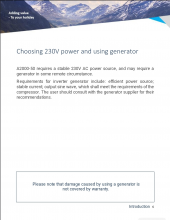Hello everyone,
I have a problem with an inverter powered air conditioning unit that happens after the A/C started and I can’t sort it out.
The inverter is an all-in-one charger/solar controller/inverter Epever UP3000-M3322 served by 8x280Ah 3,2V LiFePO4 batteries and I want to power an air conditioning unit Kronings A2000-50 EU that has a rated continuous input power of 690W. The inverter output specs are 2400W continuous, 3000W 15min., 4800W 5sec., 6000W Max surge power.
The unit runs smooth when 230v mains are connected, however when I run the inverter from batteries, the air conditioner starts shaking, making noise, and the output voltage of the inverter starts tripping.
When running the air conditioner with the inverter output set to 220V/50Hz as soon as it starts cooling it also starts shaking continuously.
When running the air conditioner with the inverter output set to 230V/50Hz as soon as it starts cooling it also starts shaking intermittently.
I’ve noticed on the inverter display that the voltage output when the A/C is cooling is not stable, it floats between 210 and 240 V. I’ve attached a video showing the display. No errors are displayed on the inverter or on the A/C unit.
The inverter powers smoothly all the other appliances like refrigerator, induction cooktop, heater, tv. I don’t have any problem with other appliances, and the output voltage stays stable. Tested up to 4000W constant load.
I hope that someone on this forum can give me an advice on how to solve this. Thank you very much
I have a problem with an inverter powered air conditioning unit that happens after the A/C started and I can’t sort it out.
The inverter is an all-in-one charger/solar controller/inverter Epever UP3000-M3322 served by 8x280Ah 3,2V LiFePO4 batteries and I want to power an air conditioning unit Kronings A2000-50 EU that has a rated continuous input power of 690W. The inverter output specs are 2400W continuous, 3000W 15min., 4800W 5sec., 6000W Max surge power.
The unit runs smooth when 230v mains are connected, however when I run the inverter from batteries, the air conditioner starts shaking, making noise, and the output voltage of the inverter starts tripping.
When running the air conditioner with the inverter output set to 220V/50Hz as soon as it starts cooling it also starts shaking continuously.
When running the air conditioner with the inverter output set to 230V/50Hz as soon as it starts cooling it also starts shaking intermittently.
I’ve noticed on the inverter display that the voltage output when the A/C is cooling is not stable, it floats between 210 and 240 V. I’ve attached a video showing the display. No errors are displayed on the inverter or on the A/C unit.
The inverter powers smoothly all the other appliances like refrigerator, induction cooktop, heater, tv. I don’t have any problem with other appliances, and the output voltage stays stable. Tested up to 4000W constant load.
I hope that someone on this forum can give me an advice on how to solve this. Thank you very much




